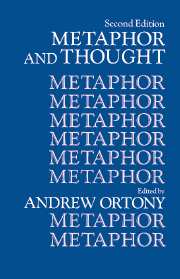Book contents
- Frontmatter
- Contents
- List of contributors
- Preface to the second edition
- Preface to the first edition
- 1 Metaphor, language, and thought
- METAPHOR AND MEANING
- METAPHOR AND REPRESENTATION
- METAPHOR AND UNDERSTANDING
- METAPHOR AND SCIENCE
- METAPHOR AND EDUCATION
- 24 The instructive metaphor: Metaphoric aids to students' understanding of science
- 25 Metaphor and learning
- 26 Learning without metaphor
- 27 Educational uses of metaphor
- References
- Author index
- Subject index
25 - Metaphor and learning
Published online by Cambridge University Press: 05 June 2012
- Frontmatter
- Contents
- List of contributors
- Preface to the second edition
- Preface to the first edition
- 1 Metaphor, language, and thought
- METAPHOR AND MEANING
- METAPHOR AND REPRESENTATION
- METAPHOR AND UNDERSTANDING
- METAPHOR AND SCIENCE
- METAPHOR AND EDUCATION
- 24 The instructive metaphor: Metaphoric aids to students' understanding of science
- 25 Metaphor and learning
- 26 Learning without metaphor
- 27 Educational uses of metaphor
- References
- Author index
- Subject index
Summary
Metaphor in education
There seem to be two main views of the role of metaphor in education. On the one hand, there is the idea that metaphors are primarily of aesthetic value, with perhaps some secondary utility as heuristic aids. This view concentrates on metaphors along with other linguistic forms, such as analogies, similes, and synecdoche, as figures of speech in literature, especially poetry. The poet's insight is often expressed through metaphor. Occasionally, proponents of the aesthetic value of metaphor also admit that it has some heuristic value in educational contexts outside of literature. For example, some of metaphor's relatives, like analogies and models are often used as teaching aids (see for example, Mayer, this volume; Petrie, 1976). The solar system model of the atom is familiar to high school physics students. But even in such a positive view of the pedagogical value of metaphors, it is usually claimed that although possibly useful and often ornamental, the metaphors and models are not essential to a cognitive understanding of what is being taught and learned. This is at least part of the position held by those whom Black (this volume) called the appreciators of metaphor.
On the other hand, metaphors occasionally receive a bad press in education. Metaphors are used when one is too lazy to do the hard, analytic work of determining precisely what one wants to say. Consequently, metaphors encourage sloppy thought. In addition, metaphors can be tremendously misleading.
Information
- Type
- Chapter
- Information
- Metaphor and Thought , pp. 579 - 609Publisher: Cambridge University PressPrint publication year: 1993
Accessibility standard: Unknown
- 47
- Cited by
